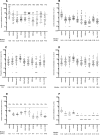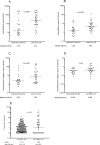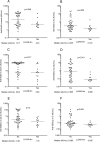Increased levels of anti-dsDNA antibodies in immune complexes before treatment with belimumab associate with clinical response in patients with systemic lupus erythematosus
- PMID: 31783909
- PMCID: PMC6884768
- DOI: 10.1186/s13075-019-2056-y
Increased levels of anti-dsDNA antibodies in immune complexes before treatment with belimumab associate with clinical response in patients with systemic lupus erythematosus
Abstract
Introduction: Immune complexes are of importance in systemic lupus erythematosus pathogenesis, and autoantibodies are believed to participate in immune complex formation. Quantification of autoantibody levels in circulating IC might be of prognostic value.
Methods: A C1q-binding-eluting technique was applied to purify immune complexes from 55 belimumab-treated systemic lupus erythematosus patients during a 24-month follow-up. Autoantibodies in serum and in solubilized immune complexes were quantified using addressable laser bead immunoassay. We investigated whether levels of autoantibodies in immune complexes associate with disease activity and response to belimumab treatment.
Results: High baseline anti-double-stranded DNA and anti-histone levels in immune complexes associated with attainment of zero scores in clinical systemic lupus erythematosus disease activity index 2000 during the 24-month follow-up (p = 0.003 and p = 0.048, respectively). Low complement levels associated with high serum anti-double-stranded DNA and anti-ribosomal P levels (p = 0.003 and p = 0.008, respectively) and high anti-double-stranded DNA (p = 0.002) but not anti-ribosomal P levels in immune complexes. Anti-SSA/SSB serum levels were lower in patients attaining lupus low disease activity state at month 6; these associations were stronger for corresponding immune complex levels. Serum levels of most autoantibodies had declined at month 3, whereas autoantibody levels in immune complexes, except for anti-double-stranded DNA, showed a more gradual decline over 1-2 years. Serum anti-double-stranded DNA levels decreased in all patients irrespective of systemic lupus erythematosus disease activity index 2000=0 attainment, whereas immune complex levels decreased only in achievers.
Conclusion: Immune complex levels of autoantibodies against double-stranded DNA and the SSA/SSB complex show more specific associations with treatment outcome compared with serum levels in belimumab-treated systemic lupus erythematosus patients. Characterization of autoantibody content in circulating immune complexes could prove useful in treatment evaluation in systemic lupus erythematosus and other immune complex-associated diseases.
Keywords: Anti-double-stranded DNA; Anti-nuclear autoantibodies; Belimumab; Immune complexes; Systemic lupus erythematosus; Therapy response.
Conflict of interest statement
The authors declare that they have no competing interests.
Figures





Similar articles
-
Autoantibody and Cytokine Profiles during Treatment with Belimumab in Patients with Systemic Lupus Erythematosus.Int J Mol Sci. 2020 May 14;21(10):3463. doi: 10.3390/ijms21103463. Int J Mol Sci. 2020. PMID: 32422945 Free PMC article.
-
Efficacy and Safety of Subcutaneous Belimumab in Anti-Double-Stranded DNA-Positive, Hypocomplementemic Patients With Systemic Lupus Erythematosus.Arthritis Rheumatol. 2018 Aug;70(8):1256-1264. doi: 10.1002/art.40511. Epub 2018 Jun 15. Arthritis Rheumatol. 2018. PMID: 29671280 Free PMC article. Clinical Trial.
-
Autoantibodies associated with RNA are more enriched than anti-dsDNA antibodies in circulating immune complexes in SLE.Lupus. 2012 May;21(6):586-95. doi: 10.1177/0961203311434938. Epub 2012 Feb 2. Lupus. 2012. PMID: 22300829
-
Diagnostic and prognostic significance of anti-C1q antibodies in systemic lupus erythematosus.Curr Opin Nephrol Hypertens. 2003 Nov;12(6):619-24. doi: 10.1097/00041552-200311000-00008. Curr Opin Nephrol Hypertens. 2003. PMID: 14564199 Review.
-
[Detection of circulating antibodies in the blood and immune complex precipitates of patients with autoimmune diseases (preliminary report)].Orv Hetil. 1992 May 3;133(18):1103-4, 1109-10. Orv Hetil. 1992. PMID: 1579350 Review. Hungarian.
Cited by
-
3-hydroxy butyrate dehydrogenase 2 deficiency aggravates systemic lupus erythematosus progression in a mouse model by promoting CD40 ligand demethylation.Bioengineered. 2022 Feb;13(2):2685-2695. doi: 10.1080/21655979.2022.2025694. Bioengineered. 2022. PMID: 35001849 Free PMC article.
-
Innovations in Biosensor Technologies for Healthcare Diagnostics and Therapeutic Drug Monitoring: Applications, Recent Progress, and Future Research Challenges.Sensors (Basel). 2024 Aug 8;24(16):5143. doi: 10.3390/s24165143. Sensors (Basel). 2024. PMID: 39204840 Free PMC article. Review.
-
Accumulation of antinuclear associated antibodies in circulating immune complexes is more prominent in SLE patients from Sudan than Sweden.Sci Rep. 2020 Dec 3;10(1):21126. doi: 10.1038/s41598-020-78213-5. Sci Rep. 2020. PMID: 33273662 Free PMC article.
-
Predictors of improvement in disease activity in first hospitalized patients with systemic lupus erythematosus: a multicenter retrospective study of a Chinese cohort.Clin Rheumatol. 2022 Nov;41(11):3355-3362. doi: 10.1007/s10067-022-06289-7. Epub 2022 Jul 18. Clin Rheumatol. 2022. PMID: 35849245 Free PMC article.
-
The Role of Belimumab in Systemic Lupus Erythematosis: A Systematic Review.Cureus. 2022 Jun 13;14(6):e25887. doi: 10.7759/cureus.25887. eCollection 2022 Jun. Cureus. 2022. PMID: 35844357 Free PMC article. Review.
References
Publication types
MeSH terms
Substances
LinkOut - more resources
Full Text Sources
Medical
Research Materials

